Analysis and purification of water from the well: how to take samples and purify water from impurities
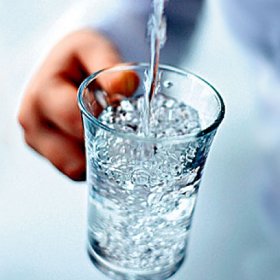
Summer residents rarely have the opportunity to use a central water supply. Usually they have to get water for themselves by digging a well or by drilling a well. But in this case there is no guarantee that the water from the depths will be absolutely safe for health, because heavy metals, iron, and various harmful emissions from nearby enterprises can get into the groundwater. In order not to endanger the infection of oneself and the family, the first thing they do is analyze the water from the well. And already on the basis of its results, they decide whether to use this water for drinking, and if not, what steps to take to clean it.
We prepare water for analysis: we take samples
Water analysis is done in sanitation, but you will have to take water from the well yourself. So, if muddy water has become in a functioning well or you just drilled a water source, be sure to take samples and take them for analysis.
But it is necessary to take samples correctly so that you do not have to return to the cottage and take water again. To obtain the most accurate results, you must follow these rules:
- The container for water intake can be plastic or glassware, whose volume does not exceed one and a half liters.
- Containers for carbonated drinks cannot be used, because inside on its walls there is a precipitate of chemicals and dyes that were added to the drinks. Some of them are not washed off even with boiling water, but when analyzing water, they can affect the results. But mineral water bottles are quite suitable.
- If you take water from an existing well connected to a water supply system, it is easiest to draw directly from the pipes. But for accurate analyzes, you must open the tap for 15-20 minutes and allow the water to drain. This is especially necessary for those summer residents who use the water supply system inconsistently. Stagnant water in the pipes will not give the correct result, so all stagnant liquid is drained. In addition, this will allow you to wash the exfoliated particles of metal, if the water supply is made by iron pipes.
- The container in which you carry water is washed a couple of times with hot water, and then rinsed with the same cold water that you will give for analysis. Do not use any chemicals. This will affect the accuracy of the analysis.
- When filling the bottle with water, the pressure should be very weak, flow in a stream. With a powerful pressure, the water will be excessively saturated with oxygen, and it will provoke unnecessary chemical reactions.
- The bottle is filled to the brim and hermetically closed with a cork. It is necessary to close so that there is no air inside, and outside it could not get in any way.
- The container is placed in a bag or bag of a dark color, through which the sun's rays do not pass.
- Samples are taken on the same day when they plan to carry the liquid to the sanitation. This is best done in the next three hours after the fence.If this does not work out, then the water can be stored wrapped in a dark bag for no more than 2 days on a shelf in the refrigerator.
Only after the results are issued, the optimal way to purify water from the well is thought out. In addition, if the summer cottage is located away from enterprises, farms and landfills, it is recommended to take water for samples once every two years. If there are a number of unsafe factors, it is better to check the water annually.
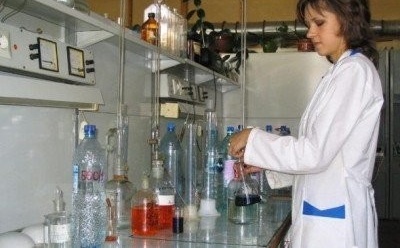
Basically, for analysis, water is brought to the laboratory in plastic bottles from under mineral water or in glass jars
How to check water quality without analysis?
It happens that the laboratory in your place of residence is absent, or for some reason you can’t reach it at all, then you can randomly determine the quality of the water according to its taste and color.
If the water in the well is cloudy, then a clogged strainer, leaching of gravel dumping, or the use of a vibration pump that destroys the casing may be the cause. The second reason why the water becomes cloudy in the well is due to siltation. Dregs are created by microscopic bacteria that urgently need to be destroyed.
If the smell of rotten eggs is clearly felt in the water, there is an excess of hydrogen sulfide in it. It’s dangerous to drink, but you don’t want to. And if the water poured from the well into the dishes stops and begins to turn yellow, leaving a residue of rust on the walls, then there is an excess of iron in it. Such water tastes like metal.
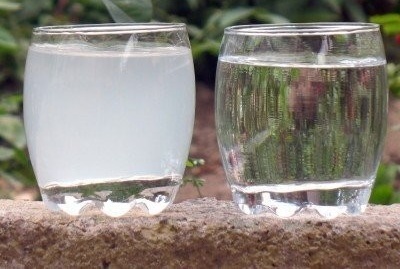
Clear water is undoubtedly not worth drinking, because its muddy hue and mud sediment at the bottom indicate poor quality and insecurity
Effective ways to restore purity
Consider how to purify water from a well in the most effective ways.
How to reduce the concentration of iron in water
It is possible to carry out iron removal from home wells in various ways. But all of them are based on the acceleration of oxidative processes, so that iron goes into a trivalent form and precipitates with solid particles that can be filtered.
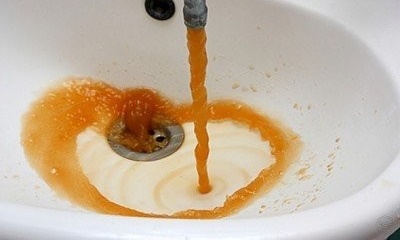
If your washbasin and the walls of the dishes are covered with a yellow coating of rust, then the concentration of iron in the water is too high
Most often, filters are used, the inner surface of which is coated with an oxidizing agent. Iron comes into contact with the walls and reacts, after which it becomes a precipitate and is cleaned with filter material. But the stronger the filter clogs, the worse it will begin to perform the deferrization function. Therefore, they must be changed frequently.
The best way, but also the most expensive, is to install reverse osmosis - a filter system and a semi-permeable membrane through which contaminated liquid is driven under pressure. As a result of cleaning, all substances dissolved in water go to the sewer, and perfectly pure water will flow from the tap. In this way, it is possible to purify water from a well from iron in high concentrations without the use of chemical oxidizing agents.
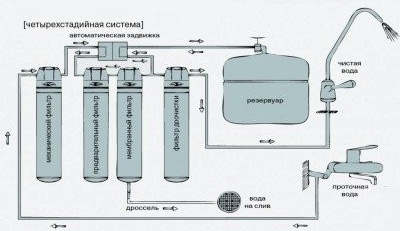
The reverse osmosis system involves several types of filters and a semi-permeable membrane through which only water molecules can pass
An example of installing a reverse osmosis system in a video:
Elimination of hydrogen sulfide
The only problem that the reverse osmosis system cannot solve is hydrogen sulfide. Its molecules are comparable in volume to water molecules, therefore, they will freely pass through the filters. In this case, it is necessary to additionally put a carbon filter, which will remove the problem by adsorption.
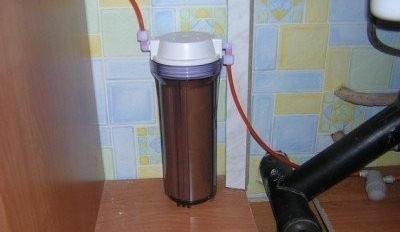
The cartridge in the charcoal filter where the active substance is located is easily removed and replaced with a fresh one when a large amount of sediment accumulates inside
Destruction of bacteria and viruses
If the analysis showed bacteria are infected with water, then the well should be disinfected with active oxygen or chlorine, and then pumped. To avoid this in the future, apply disinfection with ultraviolet light.
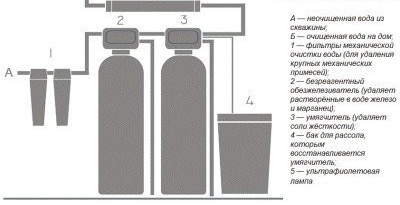
To make the water from the well as clean as possible, a whole system of filters is installed, each of which is struggling with a specific problem
The fight against nitrates, increased amounts of salts, chemical contaminants such as detergents is better to carry out comprehensively, using a reverse osmosis system.


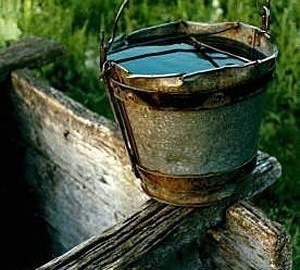
2 comments